Singapore population crosses 6 million mark
Singapore’s total population stood at 6.04 million as at June 2024, a 2 per cent rise from June 2023, the Government’s latest Population in Brief report showed.
The increase was due mainly to the 5 per cent growth in the non-resident population, which grew from 1.77 million in June 2023 to 1.86 million in June 2024, said the annual report released on Sept 24 by the National Population and Talent Division (NPTD).
The increase in non-resident workers, including work permit holders and migrant domestic workers, helped to provide much-needed services to meet Singaporeans’ social and economic needs, for instance by supporting caregiving needs, and by taking up occupations that residents are typically not keen on, such as construction jobs, said the NPTD in a statement.
Residents continued to fill higher-paying jobs, with employment growing in sectors such as financial and insurance services, information and communications and professional services, it pointed out, where high labour force participation rate remained robust and unemployment rates of residents and citizens remained very low.
Meanwhile among citizens, there were fewer births and marriages in 2023, while the proportion of seniors continued to expand.
When it came to the total population, work permit holders - semi-skilled non-professional, manager, executive and technician (non-PMET) workers - contributed most to the increase, followed by migrant domestic workers.
The citizen population rose by 0.7 per cent from 3.61 million in June 2023 to 3.64 million in June 2024, while the Permanent Resident (PR) population grew by 1.2 per cent from 538,600 to 544,900 over the same period.
Mr Christopher Gee, deputy director and senior research fellow at the Institute of Policy Studies, said this phenomenon - with nearly one in three people who were non-residents - was “not a shockingly high number” for most global cities, citing New York City as another example.
Today, the foreign workforce in Singapore makes up about two-thirds of the non-resident population, while the remaining one-third comprises mainly migrant domestic workers, dependants and students, said the NPTD report.
The annualised population growth rate of 1.1 per cent over the last five years was slightly higher than the 0.8 per cent between 2014 to 2019.
This was mostly due to post-Covid growth in the number of Work Permit Holders in the construction, marine shipyard and process (CMP) sectors as companies caught up on projects that were delayed by the pandemic, said the report.
Growth was also high for foreign workers in non-CMP sectors such as retail, F&B, hospitality and healthcare, with an 8.8 per cent increase year on year, Mr Gee noted. “Gaps in the workforce have increasingly opened up, and there is demand for their that kind of labour.”
Institute of Policy Studies (IPS) senior research fellow Gillian Koh said: “As Singaporeans, we are very aware that there is a large ramp up in the building of homes and the MRT because we need and want these. We also know that there is also global demand for some key manufacturing and pharma activities and we should never turn away business.”
She noted that from 2021, work permit holders and migrant domestic worker categories have made up more than half of the non-resident population, rising to 59 per cent in 2024. “These are not jobs that Singaporeans want or can fulfil in the numbers needed.”
Based on the current average growth rate, Mr Gee projected that Singapore will have a population of 6.37 million by June 2030.
This is “comfortably” below the projection of 6.5 to 6.9 million based on a government White Paper released in 2013, he said.
“The Government put out this white paper to articulate that it was planning for a population size of 6.9 million people, to have enough homes, public transport, infrastructure, amenities, and other things that we consider to be necessary to have a good life in Singapore infrastructure.”
“If the planning has been okay, then we should have enough of these facilities to accommodate the population size that we will have.”
He said as a “modern, diverse, and open” economy, Singapore will need to continue to bring in the skilled workers to ensure the Republic’s businesses continue its ties with the rest of the world.
Mr Gee said since Singapore’s lower-skilled workers are not allowed to bring dependants, the number of this group of non-residents here are also lower, compared to the likes of London and New York City.
The average number of new citizenships and permanent residencies granted per year over the last five years (22,400 citizenships and 32,600 permanent residencies) was slightly higher than over the preceding five years (21,600 citizenships and 31,100 permanent residencies).
Dr Koh said social integration of foreigners will be crucial in both work and social settings.
“We must also ensure that there are fair and safe working conditions for all, including our non-resident, migrant workers. How we manage this will convey to the world, what we are like, what our values are.”
Here are four other highlights from the report:
1. Ageing citizen population
In June 2024, 19.9 per cent of the citizen population was aged 65 and above, compared to 12.4 per cent in June 2014. The proportion of the citizen population in this age group is rising, and at a faster pace compared to the last decade. The number of citizens aged 80 and above also rose by about 65 per cent from 85,000 in 2014 to 142,000 in 2024.
2. Citizen births down
There were 28,877 citizen births in 2023, 5.1 per cent fewer than the 30,429 citizen births in 2022. The average number of births per year in the last five years (31,100) was also lower than in the preceding five years (33,000). The resident total fertility rate reached a historic low of 0.97 in 2023.
3. Fewer citizen marriages
In 2023, there were 24,355 citizen marriages, 1.7 per cent fewer than the record high of 24,767 citizen marriages in 2022, but higher than the 22,165 citizen marriages in 2019. The average number of citizen marriages per year in the last five years (22,800) was lower than in the preceding five years (24,000).
4. More transnational marriages
Transnational marriages made up 36 per cent of citizen marriages in 2023, up from 33 per cent in 2022. Apart from a dip in 2020 and 2021 due to Covid-related travel restrictions, the proportion of transnational marriages in the past decade has consistently been over one-third of citizen marriages each year.
Over the past decade, non-citizen brides have gotten older and more educated at the point of marriage. Of the 28,877 citizen births in 2023, more than 1 in 4 were born to couples that comprised citizens and non-citizens.
Get The New Paper on your phone with the free TNP app. Download from the Apple App Store or Google Play Store now


